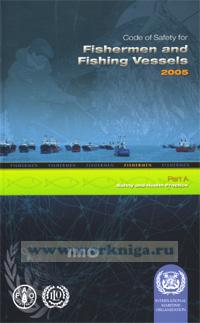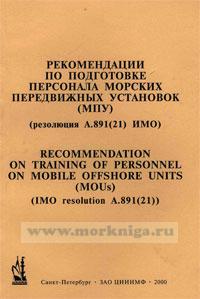Code of Safety for Fishermen and Fishing Vesselsm, Part A (2005). Safety and Health Practice
1 A resolution adopted by the Committee on Conditions of Work In the Fishing Industry, which was convened by the International Labour Organization (ILO) in December 1962 to study certain aspects of working conditions of crew on fishing vessels, recommended the creation of a practical international code dealing with navigational, operational and occupational aspects of safety of fishing vessels and crew, and urged ILO in collaboration with the Food and Agriculture Organization of the United Nations (FAO) and the Inter-Governmental Maritime Consultative Organization (IMCO)* to examine the possibility of establishing a suitable body to prepare such a code.
2 Considering that it was desirable to co-operate within their respective fields of competency, in order to extend the scope of the proposed safety code for fishing vessels to make reference to all aspects of the safety of fishing vessels and crew, the three organizations subsequently entered into an agreement with respect to the principles of cooperation and the areas of mutual interest and responsibility in the field of fishing vessels and fishing vessel crew members, namely FAO, fisheries in general; ILO, labour in the fishing industries; and IMO, safety oflife, vessels and equipment at sea.
3 Following the above agreement draft contributions to the Code ot Safety for Fishermen and Fishing Vessels were prepared by FAO, ILO and IMO. It was agreed that the Code should be divided into two parts: part A for skippers and crews, and part В for fishing vessel builders and owners.
4 Part A of the Code was adopted by the first session of the Joint FAO/ ILO/IMO Meeting of Consultants on Safety on Board Fishing Vessels which was held at ILO Headquarters in Geneva in September 1968.
5 Later amendments to Part A were approved by the IMO Maritime Safety Committee (MSC) at its thirtieth session in the Spring of 1973. At the same session, the Committee approved the final text of part В which was endorsed by the FAO Council at its 64th session (Autumn 1974) and also endorsed by the Governing Body of the ILO at its 195th session (February 1975).
6 In 1977, an International Conference on the Safety of Fishing Vessels adopted the Torremolinos International Convention on the Safety of Fishing Vessels, 1977, that for a number of reasons, has not entered into force. Consequently, a further International Conference was convened, also in Torremolinos, Spain that adopted the Torremolinos Protocol of 1993 relating to the Torremolinos International Convention for the Safety of Fishing Vessels, 1977.
7 Resolution 4 of the Conference requests IMO to review, as a matter of priority the FAO/ILO/IMO Code of Safety for Fishermen and Fishing Vessels, part A and part B. The Code of Safety for Fishing Vessels, part B, addresses safety and health requirements for the construction and equipment of fishing vessels of 24 m in length and over.
8 The MSC entrusted the revision of the Code to its Sub-Committee on Stability and Load Lines and on Fishing Vessels Safety (SLF) and recommended that the recent developments in fishing vessel design and fishing operations should be taken into consideration. The MSC also entrusted SLF to revise the Voluntary Guidelines for the Design, Construction and Equipment of Small Fishing Vessels, that had been approved by MSC in 1979, which addresses vessels of 12 m in length and over but less than 24 m in length. In this regard, IMO was requested to invite FAO and ILO to participate in the revision.
9 At its forty-second session, the SLF Sub-Committee established an intersessional correspondence group for the revision of part В of the Code and the Voluntary Guidelines. Later, at its forty-fifth session in July 2002, FAO and ILO submitted a proposal to commence the revision of part A The Sub-Committee considered that unlike the current version, which was intended to be read by crew members on fishing vessels, the revised version should be directed primarily towards Competent Authorities, training institutions, fishing vessel owners, representative organizations of the crew, and non-governmental organizations having a recognized role in crew members' safety and health and training. Competent Authorities would be encouraged to make use of the contents of the Code in the production of safety and health and training materials in an appropriate format to suit the particular needs of the fisheries of the country or region and in local languages.
10 ILO's Tripartite Meeting on Safety and Health in the Fishing Industry (December 1999), in its report to the 277th Session of the Governing Body of ILO (March 2000), had concluded, inter alia, that ILO should participate in the revision of part B, Safety and Health Requirements for the Construction and Equipment of Fishing Vessels, of the Code and, following consultation with IMO, should take a leading role in revising part A Safety and Health Practice, of the Code.
11 The revised Code and Voluntary Guidelines were approved by MSC at its seventy-ninth session in 2004 and approved by the FAO Committee on Fisheries at its twenty-sixth session in March 2005 and the Governing Body of ILO at its 293rd Session in June 2005.
12 Concerning the procedures for future amendments to the Code and the Voluntary Guidelines, MSC considered that any amendments should be effected as expeditiously as possible. It was agreed that non-controversial amendments should be approved by correspondence, but joint meetings of experts might be necessary for other amendments for which no ready agreement by correspondence could be reached,
13 Recognizing that the majority of items covered by the Code are within the scope of IMO and noting the different working procedures within the three Organizations and also that the SLF Sub-Committee holds regular meetings, it was agreed that:
.1 IMO should act as a focal point for coordinating proposed amendments to the Code and, in particular, the IMO Secretariat should undertake to receive any proposed amendments, to distribute them to the Organizations and to collate their respective comments;
.2 any future joint FAO/ILO/IMO meeting should be held, whenever possible, in conjunction with a meeting of the SLF Sub-Committee; and
.3 any proposed amendments should always be subject to the final approval of the appropriate bodies of the three Organisations.
Содержание:
Введение
1 Work at sea has never been without danger, and the fishing industry has a long and growing roll of honour of crew who have lost their lives in the performance of their work. Fortunately, loss of life In most type" of fishing is now very much less frequent than it was only a few generations ago, but no technological advances can fully eliminate the forces of the sea and other natural dangers which crew have to face, nor t" it possible to eliminate the human errors or to make the tools of the fishing activity - the fishing vessels and fishing gear - completely aeeident-preof. Fishing has, in many countries, already become a highly developed industry employing complex machinery, and this development necessitates the introduction and expansion of safety measures along lines similar to those which apply to other major industries.
2 Training has only been used as a method to promote safely In the fishing industry in developing countries in the last fifty years, The dangerous nature of the fishing industry has called for specialized training for crew members prior to going to sea. Most developed countries have already adopted this course of action and have made such course" mandatory. These countries have also sought to tackle the problem of safety in the fishing industry by having mandatory qualifications for the senior positions on board a fishing vessel. These are usually the skipper, mate and chief engineer. Dependent on the size of vessel and/or area of operation, other crew members might also require mandatory training (e.g. radio officers, etc.).
3 Although the Members of IMO decided that the collection and analysis of statistical information on casualties of fishing vessels and fatalities of crew members should be prepared on an annual basis, they acknowledged in 1999 that there had been a very limited response, This lack of information is most likely to be caused by the informal employment arrangements in fishing, which may place many crew members outside traditional occupational accident reporting systems. Knowing where and how accidents occur can identify suitable measures for intervention, The "human factor" causes many accidents, which can be attributed to inadequate training, lack of experience and skills, recklessness, under-manning and fatigue. The Competent Authority should ensure that investigation of accidents resulting in death of crew, and other Incidents resulting in damage to the vessel or severe injury to the crew, .should normally be the subject of a formal investigation.
4 Some Competent Authorities have estimated that half ot the fatalities in the fishing industry are caused by accidents to the fishing vessel. Therefore, a very effective method to reduce crew fatalities Is to ensure that the vessel Is safe. The compulsory periodical inspection of a vessel and the validation of the same by a Safety Certificate will inevitably reduce accidents to the vessels and the crew. The skipper and crew of a vessel are those most conversant with the fishing vessel, the deck machinery and the fishing gear they are operating with. They are also aware of the hazards that can occur during fishing and know when, where and how they occur. By analysing these possible hazards, the crew can play a vital role in taking preventative action to reduce or eliminate these hazards. This procedure can be assisted by a formal procedure whereby the skipper is encouraged to perform this analysis. This concept has been readily adopted in the maritime sector.
5 The high accident rates that continue to affect the fishing industry despite mandatory safety schemes and top-down approaches have encouraged safety practitioners to propose that a more holistic approach to safety and health culture in the fishing industry should be engendered. Developing safety and health awareness and promoting sensitization of the Ashing communities to take into account the cost of neglecting the safety and health issue is also advocated.
6 The economical and social conditions under which the fishing industry operates is also recommended as a potential area for study in relation to accidents at sea. This encourages investigating issues that have not traditionally been taken into account in discussing safety in the fishing industry such as the method of remuneration of the crew which, in most cases, is based on a share of the catch. This has often been cited as a contributory factor in accidents. These should be investigated to see how mitigating measures could possibly reduce the accident rate. The methods of fisheries management have also been cited as a contributory factor to accidents, and Competent Authorities should be working together to introduce safety at sea as a factor to be taken into account when introducing new fisheries management measures. On the other hand, the insurance of fishing vessels, or more specifically, the lack of it has been identified as a factor that can influence the accident rate.

 Резолюция А.667(16). Об устройствах для передачи лоцмана
Резолюция А.667(16). Об устройствах для передачи лоцмана  Резолюция MSC.94(72) Требования к оборудованию ночного видения для высокоскоростных судов (ВСС)
Резолюция MSC.94(72) Требования к оборудованию ночного видения для высокоскоростных судов (ВСС)  Рекомендации по подготовке персонала морских передвижных установок (МПУ). Резолюция А.891(21) ИМО
Рекомендации по подготовке персонала морских передвижных установок (МПУ). Резолюция А.891(21) ИМО